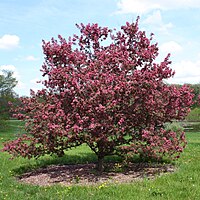
Photo from wikipedia
To elucidate the salt tolerance of Malus halliana Koehne and Malus robusta Rehd., changes of photosynthetic parameters, hormone content and chlorophyll degradation enzymes of them were compared after treated with… Click to show full abstract
To elucidate the salt tolerance of Malus halliana Koehne and Malus robusta Rehd., changes of photosynthetic parameters, hormone content and chlorophyll degradation enzymes of them were compared after treated with different concentration of NaCl. Salt stresses were simulated using 50, 100, 200 mM of NaCl solution, and 1/2 Hoagland nutrient solution was used instead of NaCl solution as control (CK). Except for the indole acetic acid (IAA) content, the changes of Chlorophyll (Chl) content, net photosynthetic rate (PN), stomatal conductance (gs), IAA/ABA ratio, intercellular CO2 concentration (Ci), transpiration rate, abscisic acid content (ABA), Pheophytinase (PPH) and Pheophorbide a monooxygenase (PaO) in Malus halliana were lower than those in Malus robusta under 100 and 200 mM NaCl condition. The values of Chlase, PPH and Pao in Malus robusta were significantly higher than that in Malus halliana. According to correlation analysis, the Chl was extremely positively correlated with Chla, Chlb, IAA/ABA, PN and gs, significantly negative correlation with Chla/b, ABA and PaO, and negative correlation with Ci, Chlase and PPH. The chloroplast ultrastructure of Malus robusta was greatly damaged resulting in chloroplasts disintegration and that of Malus halliana was maintained to be completed at 100 and 200 mM NaCl. In certain range of salt concentrations, Malus halliana could be better to adjust the levels of Chlorophyll content, Chlase, PPH, PaO and the number of starch grain and osmiophilic granules to relieve the damage of photosynthetic system due to salt stress. In a word, the Malus halliana could be better adapted to high salt concentration than Malus robusta.
Journal Title: Acta Physiologiae Plantarum
Year Published: 2019
Link to full text (if available)
Share on Social Media: Sign Up to like & get
recommendations!